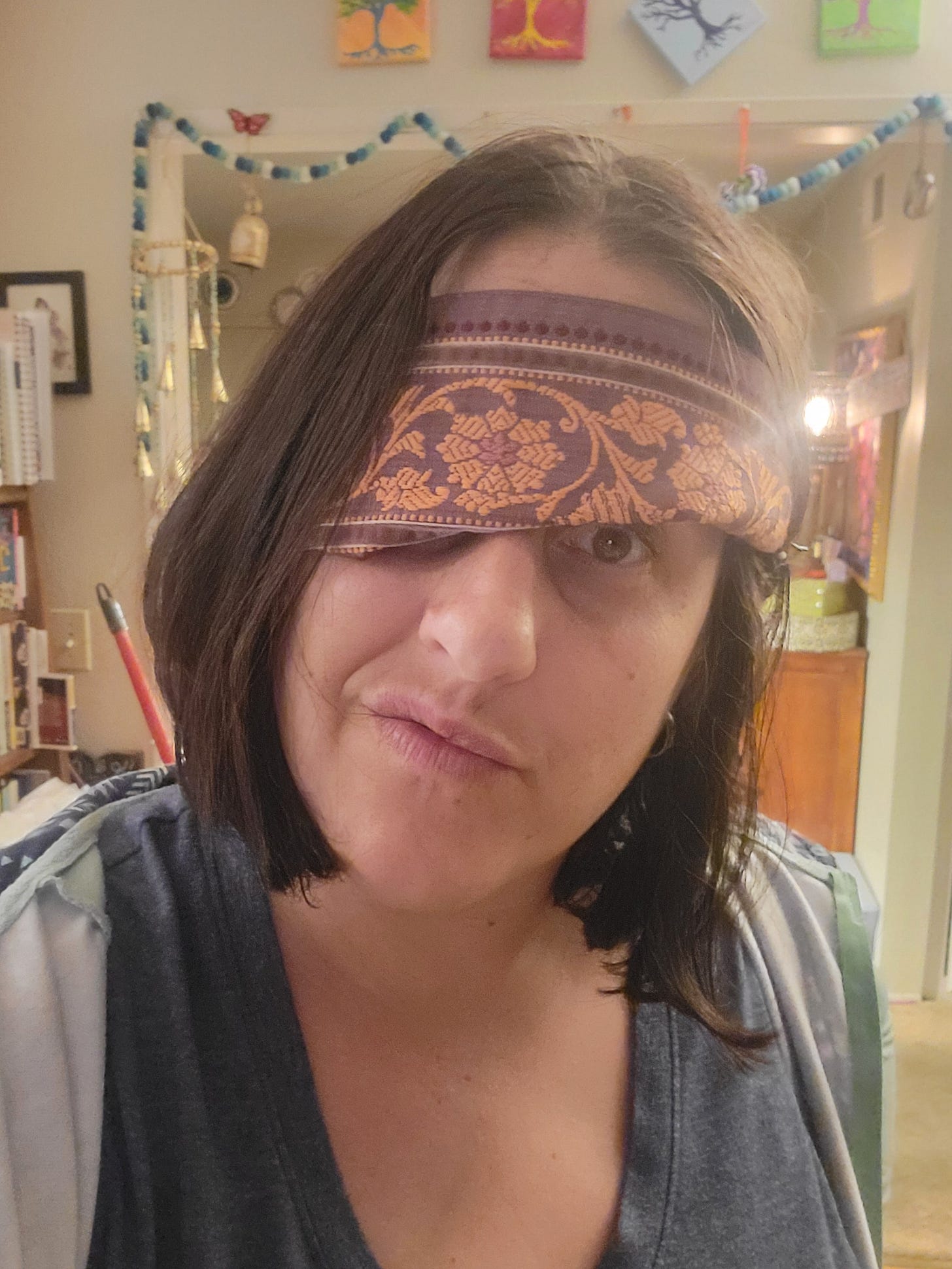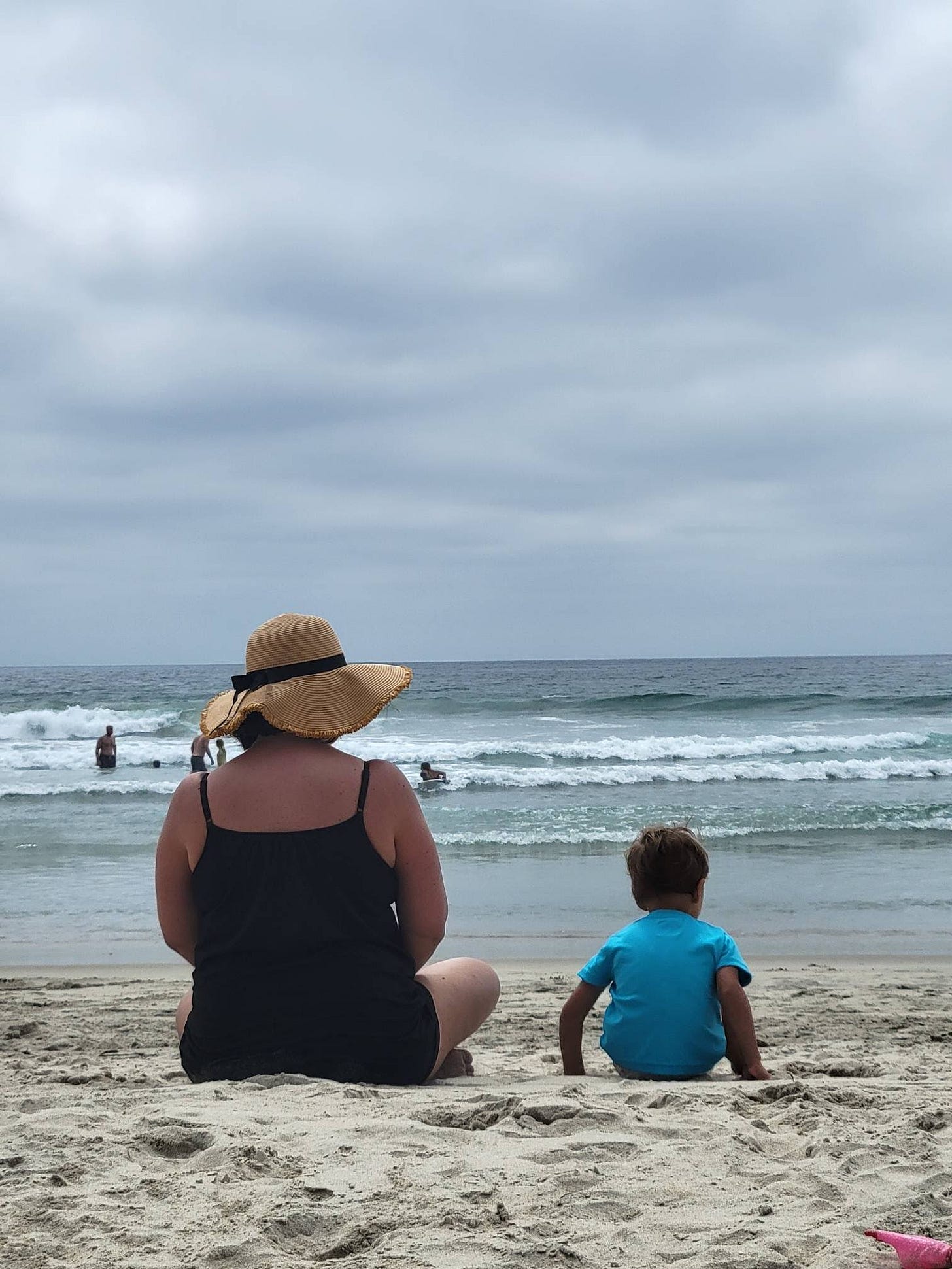Memento Mori, a Probability of 27 Quintilian, and Minion-Making Nerf Gun Injuries
About the regular scheduled programming of suffering, holy sorrow, and resilience
Today I’m kindly sending out our regularly scheduled programming to warn you to wear eye protection in Nerf gun fights. And if you’re not in a Nerf gun fight, just a normal everyday mom trying to take a shower, I’m either bidding you farewell—there is no hope for you—or you’re going have to build up some major resilience.
The Nerf bullet is coming.
Nerf Attack
My 11-year-old screamed "ambush" just as I turned the corner. A split second later, my eye was immediately filled with blinding pain, thanks to the powerful shot of the Nerf bullet that hit my open eye.
My son had obviously forgotten the rule we don't shoot above the shoulders/belly. And so, last night, in addition to a messed-up eye, nausea, and headache, I got to wear this hippie-style eye-covering. It was cool. Especially as we had guests for dinner.
Momento Mori
Parenting is just like this. There is just so much unpredictability; the probability isn’t in our favor. Actually, let’s widen this lens of this perspective (at least through my one eye that can see). Chaos is everywhere—not just parenting. It reaches to the galaxy and beyond.
—Memento Mori—
(Latin for "remember you must die")
Chaos is one of the primary default states of all experience. And not just human experience, but of creation as a whole. In my faith we consider this a result of The Fall—the brokenness of the world resulting in separation from God. Science calls it the 4th law of thermodynamics. Ancient Jewish literature referred to this chaos in the metaphors of the dark, deep, and swallowing sea. Regardless of why the chaos exists, it is here. Even in the form of Nerf bullets.
And the more we pretend chaos and everything that comes with it—from happy coincidences to, more notably, pain and suffering—isn’t a primary universal force, the more our expectations are set up for failure.
Resilience
You’re probably thinking now that this regularly scheduled programming is a downer, right? But stick with me here.
You see, I was convinced my eye was pouring blood everywhere. It hurt so much—at a level ten for at least a few minutes, and this is coming from a woman with an exceptionally high pain tolerance. But to my surprise, it wasn't gushing sticky wet crimson like the horror film I was imagining. Yes, it still hurt, and my eye was flashing, aching, throbbing, and floating neon amoebae all through my vision. But it wasn’t bleeding. I didn’t even get a black eye.
Eyes are apparently at least somewhat resilient. Just like we are.
Even if the probability of suffering is high, so is our capacity for resilient hope. These aren’t at odds; suffering and resilient hope belong together.
Minion
Today the eye doctor upgraded me to a pirate-eye covering. My toddler keeps pointing to me and shouting "minion!" And I really do see what he is getting at. (With one eye, at least.) Leave it to the little ones to find humor in others’ suffering. And his innocence makes me laugh right alongside him, as I don the persona of these ridiculous characters.
Really, though, I am grateful there is no permanent damage to my eye. Instead I just have Traumatic Iritis. This term totally sounds made-up and minion-like. Unsurprisingly, it means exactly what is sounds like:
Inflammation + pain + an eye that works poorly = eye trauma (traumatic iritis)
Patterns
I am acutely aware that this whole chaotic experience could have been worse.
But it seems to track with my own regularly scheduled programming these last five years—life going wrong. After all, this happened exactly six months to the day from when my toddler gave me a concussion. It makes me worry that in another six months from now, one of my kids might unintentionally hurt me again.
Before that it was gangrenous appendicitis—on the 17th of March. And before that, it was pregnancy and lupus and my full body crash, with the excruciating illeus—on the previous year’s 17th of March. Leading up to that, it was ICU pneumonia. And before that, I broke my foot. And of course COVID-19 and faith community divisions wove their way through all of the above.
One after the other, like a minion, I was tripping, falling, and tripping again.
I wouldn't be surprised if you, too, have stories that follow this pattern. We tend to form beliefs from these patterns. We’ll get to that in a minute, but first I want to deep-dive into the epicenter of the worst of it. Why? This is where hope shines the brightest.
Probability: 27 Quintilian
For me, my Mt. Whitney of trauma in the jarring mountain range of shifts was the score of hospitalizations and near impossible survival of my son and I through that pregnancy and post-postpartum period.
A question I regularly find myself asking is, was it actually that bad? I wonder if I just perceived it this way through my then super blurry-light-sensitive lupus eyes. Then I question if this difference even matters, as to a brain on trauma, it really doesn’t.
A couple weeks ago I decided to look things up after hearing another person describe their own statistically unlikely an illeus after abdominal surgery.1 I’d never heard anyone else talk about it and I wondered how frequent they occurred specifically after a c-section.
I spiraled down a ChatGPT rabbit hole. Within the hour I had a compiled list of the probabilities of each diagnosis, illness, etc… and put them all together (not including the unplanned intentionally prevented pregnancy itself). Guess what it was?
1 in 27,000,000,000,000,000,000
I didn’t even know 27 quintillion was a number. And yet, the probability that year of everything going wrong, just during those four trimesters, really was Mt. Whitney ridiculously high.
Of course, this doesn’t take into account everything that happened nor how they were related. These conditions don't exist in isolation. There are multiple interwoven medical, hormonal, immunological, and procedural factors that could have increased the risk of each condition or compounded them for me.
Even so: 27 quintillion.
Validation
We don’t have to have a massively high statistic to honor our experience. It could be common, a one-in-seven probability, and still matter (if we allow it to). The point is, validation is a tool.
Until we can name something—even if it isn’t official—it feels exceedingly difficult to acknowledge our limits. Our need for grace, for help, for rest, for recovery, for forgiveness, and for healing, can only be birthed from recognizing our weakness and fragility. Validating a current or past reality is part of memento mori. It is the first step to recognize the sorrow that we fall short of superhumanhood. We are unable to fix the impossible; we aren’t God.
Then, once we name the weight of a heavy load or experience, we can finally begin to grieve.
Sacred Grief
When my toddler gets even the most minor of injuries, he notices. He cares for the scratch on his perfect baby skin. He is gentle with himself, considerate of his body, and he asks for empathy from each person he meets, showing them his Band-Aid and “owie”. He teaches me that we can still be resilient and also care about our pain.
In a world of “carry on,” we don’t have to carry on—at least not yet. Minimizing sadness and suffering isn’t the answer.
My son knows how to be upset about what “ought not be.” Grief is a broad term to describe the very necessary and nonlinear process for us humans to move through sorrow and become more whole. It is a path to both connection and to freedom.
But this process demands self-kindness and the acceptance of compassion. It requires us to need.
This is what makes grief sacred. In sorrow we are positioned to unfurl in God’s love. In grief we are willing to be mended by the Spirit’s comfort.
“Where there is sorrow, there is holy ground.” - Oscar Wilde
Those Pesky Memories
At the same time I was looking up probabilities around my pregnancy experience, I was also anxious and pitter-pattery with trauma memories—especially a particular one. My therapist and I had been planning to attend to it, but it hadn’t seemed urgent until then.
In the past, I would feel too overwhelmed by triggering memories to attend to them alone. My body would shut-down as stress hormones would flood through my veins. But this time, I suspected I had the tools and resilience to dive into this one without my therapist nearby.
I sat down on a park bench, closed my eyes, and took some deep breaths. I felt empathy—a sign I could be more present—for the woman I was a mere three years ago during this traumatic moment. I was determined to write my past-self a letter, showing her compassion and put words to the traumatic experience that was a specter in my thoughts.
Instead, as I prepared to write a letter, a perspective shift played out in my mind like a movie.
A Refreshed Story: The Comforter
In my memory, an ethereal girl crawled into the hospital bed beside me. She innocently curled against me and hugged me. When I was conscious, she’d companionably chat with me. Her understanding and empathy were well beyond her years.

After helping me regulate and calm down, she told me to look around at the doctor’s and nurses. Suddenly I could see the whole experience through a different lens. Yes, it was still scary. For one, I didn’t know what was happening. I also kept picking up on the vibes of a medical worker who was acting out-of-line and over-the-top.
But as the memory unfolded, I noticed that no one else was actually distraught or worried. True, things were going wrong with my body, but the majority of the medical staff was confident. I sensed they had a handle on it. In fact, some of the nurses were even excited, which I had never given credence to before. They were viewing this as my beginning towards healing, but up until then, I’d only seen it as the full moon of my misery and fear.
Just like that, I was snapped out of the memory and heard God whisper, “I am the comforter. You didn’t know it then, but I was with you. You were going to be okay. And you are.”
Miracles
Along with the chaos of suffering, and the probabilities that specific paths of suffering will unfold, we have to take into account the unlikely series of positive probabilities in motion.
Ask any group of people and they will be split down the middle: one half of the population believes these good things are coincidences. The other half believe these are miracles of supernatural intervention.
Was I granted miracles? I believe so. I believe the only reason my son and I are alive was because I was interceded for—by God, yes, undoubtedly, for even the “professionals” were amazed. But also through the God-given scientific knowledge and wisdom leveraged by medical staff that can bring order to a body in chaos. On both counts, this was intentional, and therefore, miracles.
Maybe there were some coincidences mixed into the above, but the only coincidences that I am aware of were the ones that resulted in suffering, even if at a 27 quintillion probability. But this suffering was to be expected, the natural order of creation. Memento mori.
I’m not sure my conclusions about my experience would be the same as yours. But I’m not here to convince you otherwise.
What’s Your Worldview?
I find how we perceive reality fascinating. It’s why I studied cultural anthropology. Much of how we approach sorrow, suffering, and miracles depends on our worldview.
Here are the majority of worldviews in six points:
Chaos is our default state. However, sometimes a universal force provides supernatural intervention within it.
Goodness is the default state. A universal force sometimes adds more destruction as punishment or at least as a testing fire.
A combination of the two worldviews above.
One or more of the worldviews above, plus a healthy dose of coincidence in-between.
Life is only a series of chances and everything is a coincidence (A.K.A., classic Darwinism and the intertwined moralism of humanism).
Darwinism/humanism plus chaos theory (inherent repetition, patterns, self-organisation, interconnectedness, self-similarity, and constant feedback loops)
Which of these worldviews do you most closely align with?
Remember how earlier I was discussing patterns? And that mine told the story that my regular scheduled programming would henceforth be suffering and chaos?
These patterns are worth examining, just like our worldviews are. For our initial conclusions don’t always serve us well. Maybe they simplify the truth. Sometimes they remove us from wonder, connection with others, or they prevent us from grieving.
Often, we need a different angle, a new perspective, or even an overlay of a refreshed reality to challenge our beliefs—although hopefully not by getting our eyes shot at by a Nerf gun at close range.
All the parts of the story
You see, my body has been conditioned to brace for suffering. But I am fighting the pattern of belief that only states, “‘Momento mori,’ everything is doomed to go wrong!” I can’t forget the other elements of the story.
Here’t the element I don’t want to forget: I am able to face whatever comes. I am resilient. Maybe part of this is because of miraculous interventions. But there will be other times that I am “resilient” only because of my need—embracing sacred grief, with the Comforter at my side.
Being resilient doesn’t mean we bounce back like a rubber bands, as though nothing terrible happened. Resilience actually empowers us to become more who we were designed to be. And suffering and sorrow can be the catalyst that draws us to connection and healing love—even as Nerf bullets keep flying.
I hope this "injury or illness" by child doesn't continue to be my own regularly scheduled programming. But come what may, "Resilience" is pretty much now my middle name. Or maybe just for this week, to match my one eye, I’ll allow "Minion" to pass an acceptable term of endearment.
If this post was helpful, please tap the heart 🖤 icon, leave a comment, or reply to this email sharing something that stood out to you. Your engagement encourages me greatly. And when you engage here and/or share this, it helps these words reach others waiting for them.
Thank you.
You can find past posts visiting AuthenticallyElisa.substack.com
Follow me on Instagram here @AuthenticallyElisa or @AverageAdvocate
See what’s new on my Patheos column: Flourishing Faith and Justice
Join The Table - Average Advocate to be guided in gracious, confident changemaking
In the excellent book, This Changes Everything: A Surprisingly Funny Story About Race, Cancer, Faith, and Other Things We Don’t Talk About by Tyler Merritt (2025, Worthy Books)









